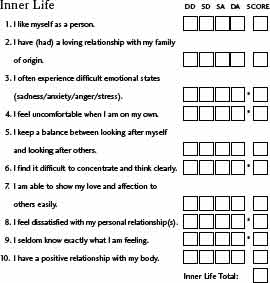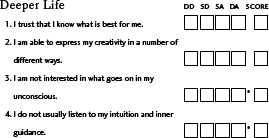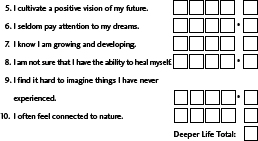Appendix
Unlived Life Inventory
This exercise will help you to assemble an inventory of unlived life. You will see qualities that you have lived, possibilities that may have been cast off or closed to you, and potentials that you still would like to fulfill. Look for unrealized and underachieved potentials. While doing this exercise, direct your attention to the past in a reflective, honest manner, not idealizing it or judging it. It is what it is. Just state what has been true for you and what is true now.
Please read each statement carefully and take a few moments to decide on a true response for yourself. Then mark the box that most nearly reflects that response. Don’t be concerned about scoring or the asterisks right now; just try to give each statement its own separate consideration.
The boxes offer a range of response from definitely disagree with the statement to definitely agree with the statement, as shown below:
DD-Definitely Disagree
SD-Somewhat Disagree
SA-Somewhat Agree
DA-Definitely agree
Outer Life






Scoring
Questions 1, 2, 5, 7, and 10, in each section (without an *), are scored: 0, 1, 2, 3, from disagree to agree.
Questions 3, 4, 6, 8, and 9, in each section, marked with an *, are scored: 3, 2, 1, 0, from disagree to agree.
Sum the scores for each section and put the totals in the boxes below.

Interpretation
Outer life is a dimension of external experiences and outer activity—how effectively and comfortably you approach the doing aspects of your life.
Inner life is a dimension of subjective experiences of your personal self—how you feel about yourself, your self-confidence, and your personal relationships with others.
Deeper life is the dimension of intuitive and creative experiences—how you relate to those aspects of your experience that seem outside conscious control.
Greater life is a dimension of the higher Self, transpersonal connection to the divine—how you relate to spirituality, core values, and aspirations.
Your score in each section is one measure of your realization and actualization of potential in that dimension.
Your total Whole Life Inventory score (out of a possible 120) gives a measure of the development and satisfaction you are experiencing in your life at present.
Scores of 15 or less in any section suggest that you have significant unlived and underdeveloped potentials in that area of your life. A measure of psychic health is your ability to experience different types of awareness and shift states (dimensions) with facility.
Your scores can help you to see where you may be over-or under-identified with certain aspects of your being. For example, you may be very comfortable with the outer dimension of life, the surface of the self, yet experience anxiety when you are required to move into inner experience (a realm that is key for feeling and relationships). Or you may score high in the greater dimension, but have difficulty paying the bills and keeping your outer life afloat. Highly spiritual people sometimes get lost in the transpersonal realm of experience.
The deeper dimension of life is the arena of symbolic impersonal knowing. Underlying consciousness, this is the foundation for your physical and psychological integration; if you scored low in the deeper dimension, review the questions again and consider how core beliefs developed from past experience may now be holding you back. Just for variety, listen to your intuition for your next decision or write down a dream to gain a different perspective.
You can use this framework—outer, inner, deeper, greater—to check in periodically with different aspects of yourself. What do you need right now to feel better? As you read through this book and develop more awareness, practice keeping an eye out for different dimensions of self-experience.
The goal is to keep a dynamic balance, accessing all the different possibilities of your self as you go through life. The path to wholeness is not about becoming cured or enlightened so much as managing different experiences and responding with resilience and creativity to life’s ongoing changes. As you tune in to its different aspects, life becomes more interesting.
Comparing the scores for different dimensions gives a picture of the areas of your life that are more lived in contrast to areas that are relatively unlived. You can use the graph below to create a visual picture.

Reflect on which dimensions of your life would benefit from more attention, and notice areas in each dimension that seem to be least developed.
The Unlived Life Inventory provides you with a glimpse of your unlived life and will help to deepen your understanding and application of material discussed in the text. When you are finished reading the book, come back to the results of this inventory and consider what practical steps you can take during the next six months to develop new potentials and possibilities in your life.